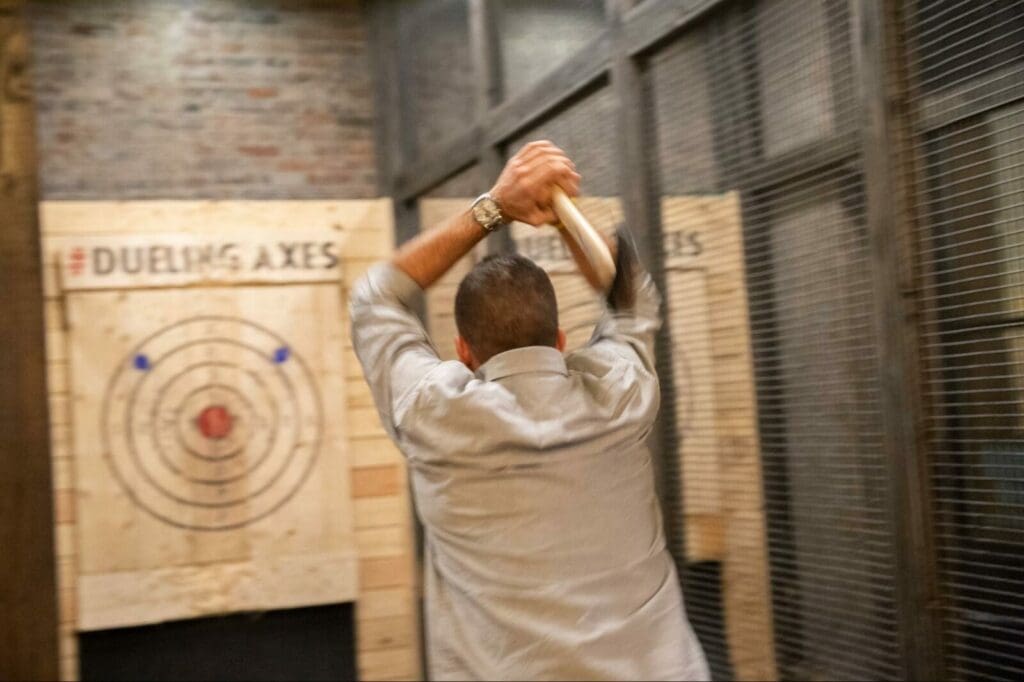Axe Throwing Denver CO: Fun for Everyone, from Friends to Families
Axe Throwing Denver CO: Fun for Everyone, from Friends to Families
Blog Article
The Fun of Axe Throwing: Exactly How This Sport Combines Skill and Adrenaline for a Great Time
Axe throwing has arised as an astounding sport that masterfully links the requirement for specific ability with the thrill of adrenaline, offering participants a engaging and one-of-a-kind experience. The act of tossing an axe in the direction of a target requires focus and method, all at once promoting an atmosphere of friendship and friendly competition. This appealing mix of psychological focus and physical exertion has made axe tossing a preferred selection for those looking for both entertainment and a feeling of success. To really appreciate the depth and charm of this activity, one must consider its beginnings, the required equipment, and the fundamental techniques that make certain both safety and security and enjoyment.
The Beginnings of Axe Throwing
Axe tossing, a leisure task that has gotten considerable appeal in current years, traces its roots back to old times. The earliest records of axe use in affordable contexts are found among the Celts and Vikings, who tossed axes for sport as well as in fight training.
Middle ages European warriors, particularly during the Middle Ages, exercised axe tossing as part of their martial training. The Francisca, a kind of tossing axe used by the Franks, became legendary for its harmful precision. This conventional tool was designed to be thrown at enemy guards and shield, showcasing its double energy in both sporting activity and battle.
In even more recent background, axe tossing saw a revival in the logging camps of The United States and copyright in the 20th and 19th centuries. Lumberjacks would certainly engage in pleasant competition, checking their accuracy and strength by aiming at wooden targets. This evolution from a survival ability to a recreational task has led the way for its contemporary revival, with specialized locations and organizations currently celebrating the sporting activity internationally.
Tools You Need
Comprehending the abundant history of axe throwing boosts the admiration of the sport's modern model. For entertainment and competitive axe tossing, the most typically used type is the hatchet, normally weighing in between 1.25 to 2 extra pounds with a handle size of about 16 inches.
Equally essential is the target. Policy targets are created from wood, with softwood ranges like yearn or cottonwood being favored for their ability to absorb and hold the axe. The target is usually divided right into five concentric circles, each with a details point worth, to promote rating.
Security equipment, though usually ignored, is vital. Safety gloves can boost hold and stop blisters, while closed-toed shoes are a must to protect feet from gone down axes (ax throwing denver). A well-lit, large tossing area, complete with security obstacles, guarantees a controlled setting where individuals can concentrate on developing their abilities.
Basic Techniques Explained
Mastering the essential techniques of axe throwing is crucial for both safety and security and efficiency. The dominant hand must be positioned straight listed below the axe head, while the non-dominant hand supports the end of the deal with.
Next, concentrate on the stance. Stand with your feet shoulder-width apart, ensuring your body is stabilized. Your leading foot should be slightly onward, straightening with your target. This positioning aids in keeping security and guiding power accurately towards the target.

Security First
Ensuring safety in axe throwing is extremely important to creating an injury-free and satisfying experience. A properly designed axe tossing center features clear separations in between tossing lanes, durable backdrops to catch roaming axes, and non-slip floor covering to protect against mishaps.
Benefits of Axe Throwing
Axe throwing offers a myriad of benefits that prolong beyond simple recreation. Literally, it supplies a full-body exercise, engaging muscular tissues in the arms, shoulders, back, and core. The repeated movement of throwing the axe likewise enhances hand-eye coordination and great electric motor skills. For those wanting to enhance their general health and fitness, axe throwing can act as a dynamic and interesting form of exercise.
Psychologically, axe tossing needs technique, accuracy, and emphasis, making it an excellent method to hone cognitive abilities. The concentration required to hit the target can function as a kind of mindfulness, enabling individuals to clear their minds and minimize stress. This mental engagement can be particularly useful in assisting people develop much better analytic abilities and mental resilience.
Socially, axe throwing is often enjoyed in team settings, fostering team-building and camaraderie. Whether as part of a business event or a laid-back trip with friends, the sporting activity urges interaction and partnership. Additionally, the communal experience of finding out and boosting together can reinforce partnerships and develop long lasting memories.
Conclusion

The earliest records of axe use in affordable contexts are located amongst the Celts and Vikings, that tossed axes for sporting activity as well as in fight training. Release the axe when your hands are around at eye degree, allowing the axe's natural rotation to assist it in the direction of the target.
A well-designed axe throwing facility functions clear separations between tossing lanes, tough backgrounds to capture roaming axes, and non-slip flooring to prevent mishaps. Participants need to be advised on the right way to deal with and throw the axe, highlighting controlled, deliberate movements over forceful tosses.
In summary, axe tossing stands out as a sport that masterfully integrates adrenaline, accuracy, and skill.
Report this page